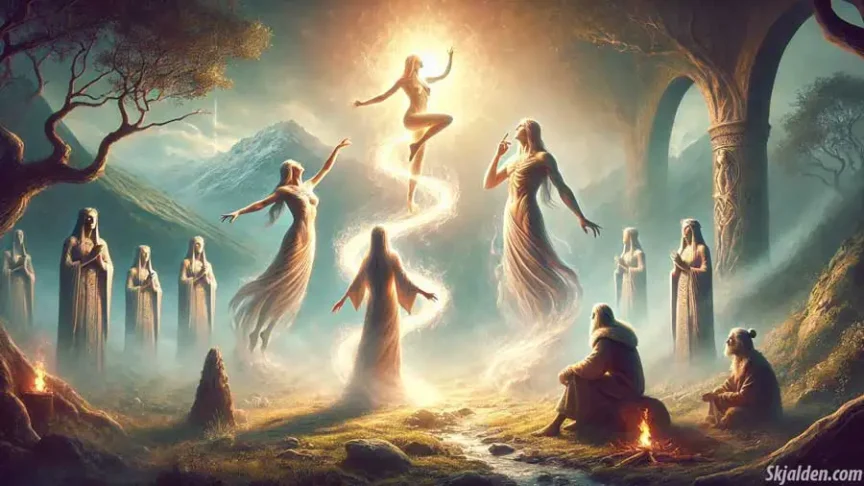In Norse mythology, the soul is complex, composed of several elements rather than a single entity. One element that often captures attention is Önd, which translates from Old Norse as ‘breath’ or ‘spirit.’ This discussion seeks to explore whether Önd, traditionally viewed as the vital life force animating gods and mortals, should indeed be considered an integral part of the soul.
The Creation of Ask and Embla
The story of Ask and Embla, the first humans according to Norse mythology, offers crucial insights into the essence of Önd. In the Poetic Edda’s “Völuspá” stanza 18:
Icelandic (Old Norse):
“Önd þau ne áttu, óð þau ne höfðu,
lá né læti né litu góða;
önd gaf Óðinn, óð gaf Hœnir,
lá gaf Lóðurr ok litu góða.”
English Translation:
“Soul they had not, sense they had not,
Heat nor motion, nor goodly hue;
Soul gave Othin, sense gave Hönir,
Heat gave Lothur and goodly hue.”
This foundational act illustrates Önd as more than mere breath; it is portrayed as the essential spark that transforms inanimate material into living, sentient beings.
The Impact of Önd
Beyond its foundational role in creation myths, the influence of Önd permeates various sagas, where it significantly enhances the capabilities of heroes. This element does not simply endow physical vitality; it amplifies inherent abilities, allowing heroes to perform feats that surpass the boundaries of ordinary human capabilities.
Heroic Feats Enhanced by Önd
Grettir the Strong: In his saga, Grettir invokes the aid of Thor, receiving not just bravery but also exceptional strength. This enhancement by Önd allows him to confront supernatural threats and overcome overwhelming odds, feats that are emblematic of his legendary status in Norse lore.
Angantyr in the Saga of Hervor and Heidrek: Through the power of Önd bestowed by Odin, Angantyr acquires not only increased physical strength but also a pearl of profound strategic wisdom. These gifts enable him to tactically outmaneuver enemies and succeed in battles that require both brawn and brain.
Impact of Önd on Heroic Narratives
These narratives illustrate that Önd serves a crucial function beyond mere life-giving. It acts as a catalyst that enhances the spiritual and physical aspects of individuals, transforming them into figures of legend. The tales of Grettir and Angantyr demonstrate that Önd bestows abilities that are both extraordinary and essential for fulfilling one’s destiny within the epic framework of Norse mythology.
The enhancement provided by Önd is not random but targeted, elevating those aspects of a hero that are most needed, whether it be strength for a warrior or wisdom for a leader. This selective enhancement suggests a deeper connection between Önd and the fates of these characters, hinting at a divine orchestration and a predetermined path that these heroes are meant to follow.
Philosophical Significance of Önd in Heroic Contexts
This portrayal of Önd in Norse sagas also prompts a reflection on its broader philosophical implications. By empowering heroes with supernatural abilities, Önd challenges the notion of fate and free will in Norse mythology.
It raises questions about the extent to which these heroes control their destinies versus being instruments of divine will. Moreover, Önd’s role in these stories emphasizes the Norse cultural value placed on heroism and the extraordinary, reflecting societal ideals of strength, courage, and strategic acumen.
Cultural and Spiritual Significance of Önd
In Norse spiritual practices, particularly in the ritualistic art of Seidr, Önd is essential for harnessing and manipulating mystical energies. Practitioners of Seidr, known for their deep spiritual connections, focus intensely on controlling their breath, which they believe is a direct manipulation of Önd.
This practice suggests that Önd serves as a conduit between the mundane and the divine, facilitating a bridge that connects the tangible world with unseen spiritual forces.
This vital role of Önd not only illustrates its importance in daily Norse life but also highlights its sacred status within the broader Norse cosmology. It is revered not merely as a component of being but as a fundamental essence that interacts continuously with the forces governing the universe.
Furthermore, the reverence for Önd transcends typical spiritual respect, positioning it as a central pillar in the Norse understanding of life and the universe’s functioning. It is deeply integrated into the rituals that mark significant life events, from birth to death, underscoring its role as a life-sustaining force that is both revered and feared.
This dual nature of Önd—both life-giving and profoundly mystical—enhances its cultural and spiritual significance, painting it as a critical element of Norse spiritual identity and existential philosophy.
Philosophical Implications
Exploring the capabilities of Önd raises significant philosophical questions about its nature and its role within the Norse concept of the soul. Is Önd merely a functional element, responsible for the animation of life forms, or does it represent a deeper, more intrinsic quality of existence?
The way that Önd empowers beings with not just life but extraordinary powers suggests that it might embody the very essence of what many philosophies might define as a soul—a central force of life and consciousness.
In Norse thought, Önd’s presence in all living beings and its role in key mythological narratives suggest that it could be viewed as the essence of life itself. By bestowing not only vitality but also spiritual and mystical capabilities, Önd transcends the role of a mere life force.
It becomes a fundamental characteristic of existence, linking beings to the spiritual world and enabling them to perform feats beyond ordinary capacities.
This suggests that in the Norse worldview, Önd could be equivalent to what is often considered a soul in other cultures—a core attribute that defines identity, consciousness, and one’s place in the cosmic order.
By equipping individuals with the ability to exceed human limitations and connect with the divine, Önd aligns with many attributes traditionally associated with the soul.
This exploration into the nature of Önd encourages a reevaluation of its role not just in Norse mythology but in the broader philosophical discourse about the essence of life and spirituality.
